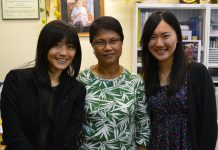Learning about death helps youngsters get the most out of life
By Yoyo Chan and Tommy Lee
“I am happy to have cancer,” says William Chan Wai-lam.
Chan, a 30-year-old with a pudding bowl haircut and preference for the name William Outcast, sits and smiles broadly. Half of his body is covered in countless black dots and passers-by cannot help but stare at him.
Chan is used to the stares. He was born with the dots. Each dot is a melanoma, a tumour of skin cancer. “They hurt like having stones in your shoes,” says Chan. There have been acute episodes – Chan was once admitted to hospital after vomiting blood. He was told to say his goodbyes to his family and was transferred to the intensive care unit. He knows that at any moment, the cancer could spread and kill him. He has lived with death all his life.
In July last year, Chan organised his own funeral and invited 200 friends and relatives to mourn his “death” and celebrate his life. Chan conceived it as a class in life and death education and, indeed, it is probably the highest profile life and death education event ever to be held in Hong Kong.
Life and death education refers to teaching about the concept of death itself. In traditional Chinese society, death is taboo and represents misfortune. People will try to avoid saying words that sound similar to “death” during the Chinese New Year or even skip the fourth floor of buildings. When a member of the family dies, the rest of the family is expected to avoid visiting others’ homes or attending weddings. The purpose of life and death education is to break these taboos and to help people to rethink the value of life through understanding death.
After his funeral last summer, Chan dedicated himself to various forms of life and death education. He held an art exhibition and conducted workshops and talks at schools. “Death is good,” says Chan. “Through death we find the value [of life].”
For Chan, it is not a pity to die as long as you pursue your dream in life. Chan himself is a living example of this belief. But he is not alone in recognising the importance of life education.
Wallace Chan Chi-ho, assistant professor in the Department of Social Work at the Chinese University of Hong Kong (CUHK), offers a course on grief and life education. Although most people may see such education as something that focuses on the elderly and those facing imminent death, Wallace Chan believes it is also meaningful for teenagers.
“It is a very important topic children may barely touch upon. But eventually they will come across it somehow,” says Chan. “Do we have to wait till death strikes before we start to learn from it?”
Chan shows his students films and plays songs, then he holds discussions afterwards. The aim is to make death and bereavement seem less heavy. Students are invited to join a life experiment by asking what they would want to do if their time on earth were limited. Then they are encouraged to make some changes in life. Chan recalls one student who did not have real or meaningful communication with his sister. The exercise pushed him to reconnect with her.
Apart from lectures, he also arranges for students to visit to the Faculty of Medicine to learn about the dead bodies used for anatomy education. Students can even enroll for an optional visit to a crematorium to experience what it is like behind-the-scenes when the practicalities of death have to be handled.
Chan thinks these activities are a great opportunity for teenagers to reflect upon the value of life during their years at university, when they are in the transition between being students and being regarded as adults. “It is never too young to know about death and dying,” he says.
But for some, death may hit before any such preparation or knowledge. In these cases, life and death education can also be gained from bereavement counselling. Sometimes death may even provide an impetus for life.
Esther Poon Tsui-ying was 14 when she lost her father.
“When he passed away I didn’t know how to adapt to such drastic change. I cried for months,” says Poon. “Schools and textbooks didn’t teach us how to deal with the death of family members.”
Poon was introduced to a bereavement counsellor who asked her to compile a journal about her past experiences with her father. The counsellor asked her to draw pictures and write letters to her dad to express both her thanks and anger towards him.
This helped Poon to come to terms with her feelings, a process that was further helped along by engaging in voluntary work.
“I also became a volunteer to help other families who had experienced bereavement. It reminded me that I was not the most unfortunate one,” she says.
Eventually, the counselling and voluntary work not only influenced her values, but also her career path. She is currently studying for a degree in social work at Shue Yan University. “Life education is more than telling you what to do when you face deaths, it aims to reflect values in lives,” says Poon.
However, not every teenager can address grief and death so easily. Poon’s brother, who was 12 when their father died, responded to his passing by hiding in his room and expressing his emotions violently.
Rex Wong Chi-on, the centre director of the Comfort Care Concern Group that provides grief counselling, has come across young people who respond to grief by acting out.
“It is good to vent emotions in healthy ways such as playing ball games, running and swimming. But things can get complicated if [young people] do it through means such as self-mutilation, or compensated dating,” says Wong. He recalls the case of a teenager who became addicted to drugs after the loss of her father and was admitted to drug rehabilitation facilities.
Another long-term impact of death on young people is that they may develop a sense of insecurity and fear of sudden separation. This could shape their personality, leading to a lack of trust and fear of forming intimate relationships
Wong explains that more than 80 per cent of people can handle grief without the need of counselling. But for the others, resources are woefully inadequate. He says there are roughly 40,000 deaths per year in Hong Kong. At a conservative estimate that means one out of 10 deaths will lead to a child with a problem grieving, and that ten per cent of those cases will require professional aid, “It would only be 400 children, but the service in Hong Kong can’t even support that,” says Wong.
There are currently fewer than five organisations in Hong Kong providing specialised grief counselling services and life education. Wong says there is only one full time worker and a few counsellors at their centre. They can only handle around 60 cases a year.
The lack of sufficient services and support is also experienced by Christina Li Yan, the founder and grief counsellor of Heart-to-heart Life Counselling & Education.
Li started the service after her fiancé died from a heart attack and she lost her mother to renal failure just nine months later. Confronted with this double loss, Li sought grief counselling from non-government organisations but was asked to return in two months. So she ended up using a costly private counselling service that did not specialise in grief counselling.
Li – who has a master’s degree in counselling and received related training at the Prince of Wales Hospital – set up Heart-to-heart to try to bridge the gap between the need and supply. She provides counselling in the evening at flexible venues and offers life and death courses that are aimed at the layman rather than professionals such as social workers and nurses. The response was not ideal at first. “The course failed to start because not enough people signed up,” says Li, “But when it did, the participants said it was rewarding.”
There is little attention paid to life and death education in Hong Kong and some may even question whether it is necessary. The young, in particular, may feel it is a very distant subject. But death is always present in our daily life.
A happy boat trip to watch the fireworks on the October 1National Day, suddenly turned into a tragedy last year. Families watched television reports of bodies being transported from the scene of the accident onto the shore. For some of the children and teenagers watching, this was their first encounter with real deaths.
Yiu Chi-kin, registered social worker in Children Counselling Service of Caritas Family Crisis Line and Education Centre, says they received phone calls from children expressing their feelings on the calamity. “They may feel uncomfortable about witnessing such uneasy scenes. And some of them said it led to nightmares.” says Yiu.
Life and death education can also be taught through less tragic examples. Yiu suggests parents make use of examples from ordinary daily life such as the Ching Ming Festival and news reports that involve casualties to educate children about what death is. He says parents should not avoid discussing death but should instead understand children’s curiosity. “Don’t use ambiguous words such as ‘gone’ and ‘Dad left us’. Will they be back if they were just gone? We should be aware of this,” says Yiu.
Yet, there is one thing that must be remembered. “We also need to let them know, no matter how well you feel you are prepared, this is something you can never be prepared for,” says Chan Chi-ho, the social work teacher from CUHK. “There is always uncertainty in life. This is the nature of death.”
Edited by Derek Li











































Maybe “end of life services” via social enterprise platform can incorporate into your curriculum